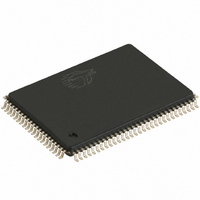CY7C1354CV25-166AXC Cypress Semiconductor Corp, CY7C1354CV25-166AXC Datasheet - Page 7

CY7C1354CV25-166AXC
Manufacturer Part Number
CY7C1354CV25-166AXC
Description
IC SRAM 9MBIT 166MHZ 100LQFP
Manufacturer
Cypress Semiconductor Corp
Type
Synchronousr
Datasheet
1.CY7C1354CV25-200AXC.pdf
(30 pages)
Specifications of CY7C1354CV25-166AXC
Memory Size
9M (256K x 36)
Package / Case
100-LQFP
Format - Memory
RAM
Memory Type
SRAM - Synchronous
Speed
166MHz
Interface
Parallel
Voltage - Supply
2.375 V ~ 2.625 V
Operating Temperature
0°C ~ 70°C
Access Time
3.5 ns
Maximum Clock Frequency
166 MHz
Supply Voltage (max)
2.625 V
Supply Voltage (min)
2.375 V
Maximum Operating Current
180 mA
Maximum Operating Temperature
+ 70 C
Minimum Operating Temperature
0 C
Mounting Style
SMD/SMT
Number Of Ports
4
Operating Supply Voltage
2.5 V
Lead Free Status / RoHS Status
Lead free / RoHS Compliant
Lead Free Status / RoHS Status
Lead free / RoHS Compliant, Lead free / RoHS Compliant
Other names
428-2121
CY7C1354CV25-166AXC
CY7C1354CV25-166AXC
Available stocks
Company
Part Number
Manufacturer
Quantity
Price
Company:
Part Number:
CY7C1354CV25-166AXC
Manufacturer:
Cypress Semiconductor Corp
Quantity:
10 000
Company:
Part Number:
CY7C1354CV25-166AXCT
Manufacturer:
Cypress Semiconductor Corp
Quantity:
10 000
Pin Definitions
Document Number: 38-05537 Rev. *K
A0
A1
A
BW
BW
WE
ADV/LD
CLK
CE
CE
CE
OE
CEN
DQ
DQP
MODE
TDO
TDI
TMS
TCK
V
Pin Name
DD
1
2
3
S
a,
c,
X
BW
BW
b,
d
JTAG serial output
JTAG serial input
Test mode select
Input strap pin
asynchronous
Power supply
synchronous
synchronous
synchronous
synchronous
synchronous
synchronous
synchronous
synchronous
synchronous
synchronous
synchronous
synchronous
synchronous
JTAG-clock
I/O Type
Input-
Input-
Input-
Input-
Input-
Input-
Input-
Input-
Input-
Input-
clock
I/O-
I/O-
Address inputs used to select one of the address locations. Sampled at the rising edge of
the CLK.
Byte write select inputs, active LOW. Qualified with WE to conduct writes to the SRAM.
Sampled on the rising edge of CLK. BW
BW
Write enable input, active LOW. Sampled on the rising edge of CLK if CEN is active LOW. This
signal must be asserted LOW to initiate a write sequence.
Advance/load input used to advance the on-chip address counter or load a new address.
When HIGH (and CEN is asserted LOW) the internal burst counter is advanced. When LOW, a
new address can be loaded into the device for an access. After being deselected, ADV/LD should
be driven LOW in order to load a new address.
Clock input. Used to capture all synchronous inputs to the device. CLK is qualified with CEN.
CLK is only recognized if CEN is active LOW.
Chip enable 1 input, active LOW. Sampled on the rising edge of CLK. Used in conjunction with
CE
Chip enable 2 input, active HIGH. Sampled on the rising edge of CLK. Used in conjunction with
CE
Chip enable 3 Input, active LOW. Sampled on the rising edge of CLK. Used in conjunction with
CE
Output enable, active LOW. Combined with the synchronous logic block inside the device to
control the direction of the I/O pins. When LOW, the I/O pins are allowed to behave as outputs.
When deasserted HIGH, I/O pins are tri-stated, and act as input data pins. OE is masked during
the data portion of a write sequence, during the first clock when emerging from a deselected state
and when the device has been deselected.
Clock enable input, active LOW. When asserted LOW the clock signal is recognized by the
SRAM. When deasserted HIGH the clock signal is masked. Since deasserting CEN does not
deselect the device, CEN can be used to extend the previous cycle when required.
Bidirectional data I/O lines. As inputs, they feed into an on-chip data register that is triggered
by the rising edge of CLK. As outputs, they deliver the data contained in the memory location
specified by addresses during the previous clock rise of the read cycle. The direction of the pins
is controlled by OE and the internal control logic. When OE is asserted LOW, the pins can behave
as outputs. When HIGH, DQ
automatically tri-stated during the data portion of a write sequence, during the first clock when
emerging from a deselected state, and when the device is deselected, regardless of the state of
OE.
Bidirectional data parity I/O lines. Functionally, these signals are identical to DQ
write sequences, DQP
BW
Mode input. Selects the burst order of the device. Tied HIGH selects the interleaved burst order.
Pulled LOW selects the linear burst order. MODE should not change states during operation.
When left floating MODE will default HIGH, to an interleaved burst order.
Serial data-out to the JTAG circuit. Delivers data on the negative edge of TCK.
Serial data-in to the JTAG circuit. Sampled on the rising edge of TCK.
This pin controls the test access port state machine. Sampled on the rising edge of TCK.
Clock input to the JTAG circuitry.
Power supply inputs to the core of the device.
2
1
1
c
c
and CE
, and DQP
and CE
and CE
controls DQ
2
3
3
to select/deselect the device.
to select/deselect the device.
to select/deselect the device.
d
is controlled by BW
c
and DQP
a
is controlled by BW
c
a
, BW
–DQ
d
d
controls DQ
are placed in a tri-state condition. The outputs are
d
.
a
Pin Description
controls DQ
a
, DQP
d
and DQP
b
is controlled by BW
a
and DQP
d
.
a
, BW
b
controls DQ
b
, DQP
CY7C1354CV25
CY7C1356CV25
c
is controlled by
[a:d].
b
and DQP
During
Page 7 of 30
b
,
[+] Feedback











